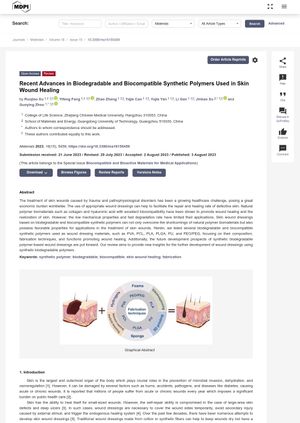Recent Advances in Biodegradable and Biocompatible Synthetic Polymers Used in Skin Wound Healing
August 2023
in “
Materials
”
biodegradable synthetic polymers biocompatible synthetic polymers PVA PCL PLA PLGA PU PEO PEG hydrogel formation electrospinning freeze drying solvent casting particle leaching 3D printing bioactive compounds antibacterial agents growth factors herbal extracts natural polymers drug delivery anti-inflammatory substances intelligent wound dressings personalized wound dressings scarless healing polyvinyl alcohol polycaprolactone polylactic acid poly(lactic-co-glycolic acid) polyurethane polyethylene oxide polyethylene glycol hydrogels nanofibers sponges smart wound dressings customized wound dressings

TLDR New synthetic polymers help improve skin wound healing and can be enhanced by adding natural materials and medicines.
The document discusses the use of biodegradable and biocompatible synthetic polymers such as PVA, PCL, PLA, PLGA, PU, and PEO/PEG in skin wound healing. These polymers can be fabricated into different materials like gels, nanofibers, and sponges, and their properties can be controlled to meet the treatment needs of different types of wounds. Various fabrication techniques like hydrogel formation, electrospinning, freeze drying, solvent casting/particle leaching, and 3D printing are used. The polymers can be loaded with bioactive compounds like antibacterial agents, growth factors, and herbal extracts to improve wound healing. However, some synthetic polymers have limitations like poor hydrophilicity, fewer binding sites for cell adhesion and proliferation, and lack of antibacterial or anti-inflammatory properties. These issues can be addressed by combining natural polymers with synthetic ones and/or delivering drugs, growth factors, and anti-inflammatory or antibacterial substances. Future developments in wound dressings include intelligent, personalized, high-end complex functions, real-time self-monitoring, and scarless healing treatments.

